I have a matrix variable in size where 1 indicates the cell such as:
Cells = [[0,0,0,0,0],
[0,0,0,0,0],
[0,0,1,0,0],
[0,0,0,0,0],
[0,0,0,0,0],
]
I need to find neigbours in a parametric sized diamond shape. Not a box as answer given in here or not a fixed sized 1 diamond, answer given here. For example, N=2 I want to know the column, rows for below:
Mask = [[0,0,1,0,0],
[0,1,1,1,0],
[1,1,0,1,1],
[0,1,1,1,0],
[0,0,1,0,0],
]
The function should receive x and y for the requested column and row, (for above I will input 2,2) and N (input 2) the size of diamond. The function should return list of tuples (x,y) for the given diamond size.
I struggled at defining the shape as a function of x, y and k in for loops. I need to know both numpy (if there is anything that helps) and non-numpy solution.


